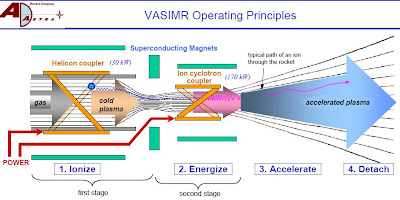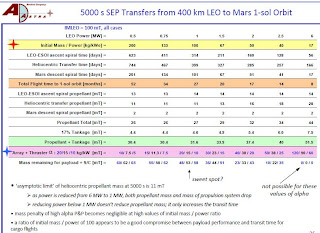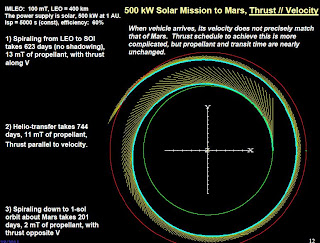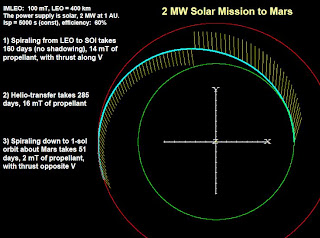Ad Astra has demonstrated 60% propulsion system efficiency (DC to jet power) at an Isp of 4800 seconds and an input power of 220 kW DC
• The ratio of mass to power (alpha) of solar arrays and thrusters establishes the payload fraction achievable for SEP
• Concentrator solar arrays are essential to achieving alpha values low enough for SEP to be attractive for unmanned Mars flights
• In the near term (five years?), a combined array + thruster alpha of 20 kg/kW seems within reach, at power levels on the order of hundreds of kW
• For this value of alpha, SEP payload fraction is comparable to that for nuclear thermal rocket propulsion, though with a transit time three times longer (27 months)
• The estimated cost per kW for concentrating solar arrays ($500/watt) makes SEP an attractive enhancement for near-term Mars science missions, approximately doubling the Mars payload capability of existing launch vehicles, at the expense of longer flight time
There was the design of the SAFE – 400 space fission reactor (Safe Affordable Fission Engine) It weighs 512 kg and can generate 100 Kilowatts of electrical power.
Status of Nuclear power for space
SAFE400 is a 400 kWt HPS producing 100 kWe to power a space vehicle using two Brayton power systems – gas turbines driven directly by the hot gas from the reactor. Heat exchanger outlet temperature is 880°C. The reactor has 127 identical heatpipe modules made of molybdenum, or niobium with 1% zirconium. Each has three fuel pins 1 cm diameter, nesting together into a compact hexagonal core 25 cm across. The fuel pins are 70 cm long (fueled length 56 cm), the total heatpipe length is 145 cm, extending 75 cm above the core, where they are coupled with the heat exchangers. The core with reflector has a 51 cm diameter. The mass of the core is about 512 kg and each heat exchanger is 72 kg.
If you liked this article, please give it a quick review on ycombinator or StumbleUpon. Thanks

Brian Wang is a Futurist Thought Leader and a popular Science blogger with 1 million readers per month. His blog Nextbigfuture.com is ranked #1 Science News Blog. It covers many disruptive technology and trends including Space, Robotics, Artificial Intelligence, Medicine, Anti-aging Biotechnology, and Nanotechnology.
Known for identifying cutting edge technologies, he is currently a Co-Founder of a startup and fundraiser for high potential early-stage companies. He is the Head of Research for Allocations for deep technology investments and an Angel Investor at Space Angels.
A frequent speaker at corporations, he has been a TEDx speaker, a Singularity University speaker and guest at numerous interviews for radio and podcasts. He is open to public speaking and advising engagements.











